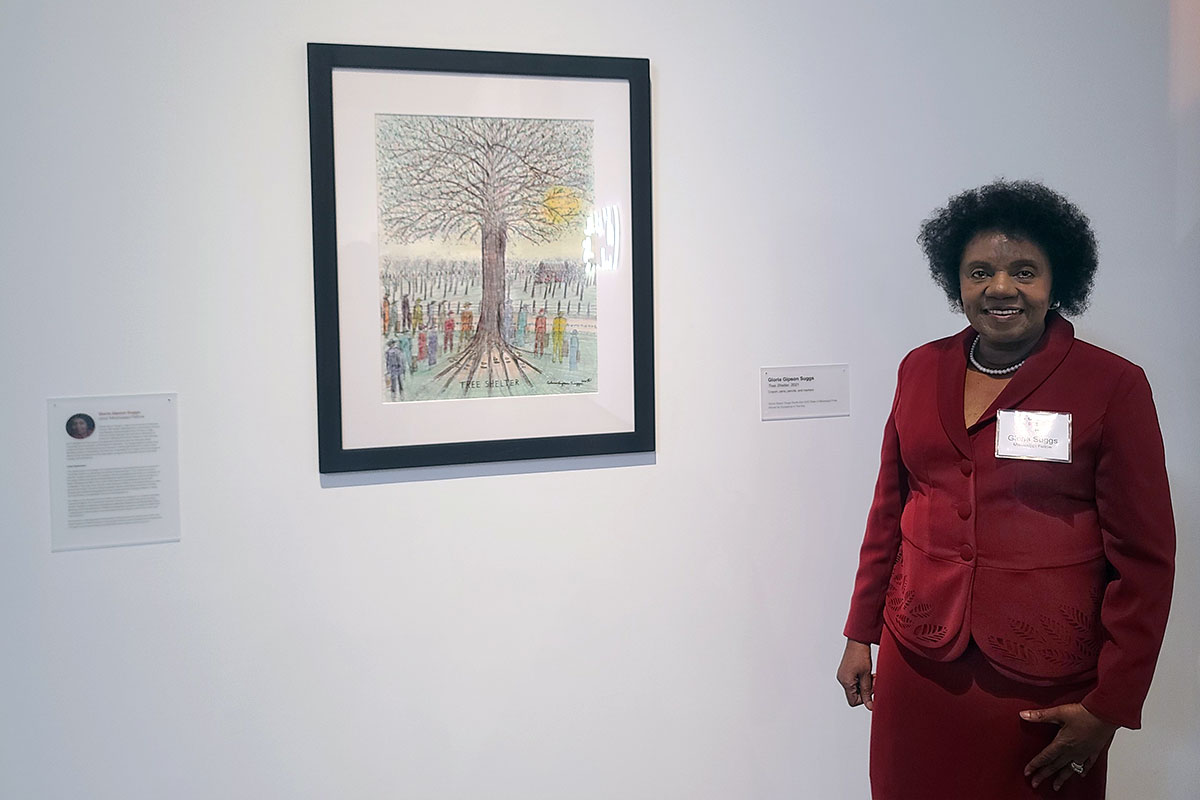It began with a request for crayons. In the midst of recovery from a traumatic head injury that abruptly changed the course of Gloria Gipson Suggs’ life and career as an educator, the Marshall County, Miss., native found a new way forward. Crayons became the tools that helped draw the way.
“It changed my whole life, because I didn’t know about the joy I would get from going through this pathway of art,” Suggs says. South Arts recently selected her as its 2022 Mississippi Fellow, a recognition that also awards a $5,000 fellowship to one artist in each of the nine states in the South Arts region. The program celebrates whom the organization deems among the highest quality visual artists working in the South.
Suggs’ images of a Southern rural past, rendered in a primitive impressionism style in crayon, pencil, markers and pens, are suffused with heart even as they depict hard times and remnants of the area’s plantation past. Preservation of heritage and cultural pride is her mission, in art that recalls eras of one-room schoolhouses, quilting parties, mule-drawn plows, and travels by foot and by train.
In idyllic images of yesterday’s American South, “She hints, through the inclusion of racialized architectural spaces, at the divisions of our past as we flirt with said divisions in real time,” Michaela Pilar Brown, curator of the South Arts 2022 Southern Prize and State Fellows exhibition, writes in the exhibition catalog. These works that bear truths of that division are still possessed of joy, Brown continues. “In ‘Tree Shelter’ (2021), a radiant light permeates the center of the frame marking a space of congregation, a chosen space, a Black space.”
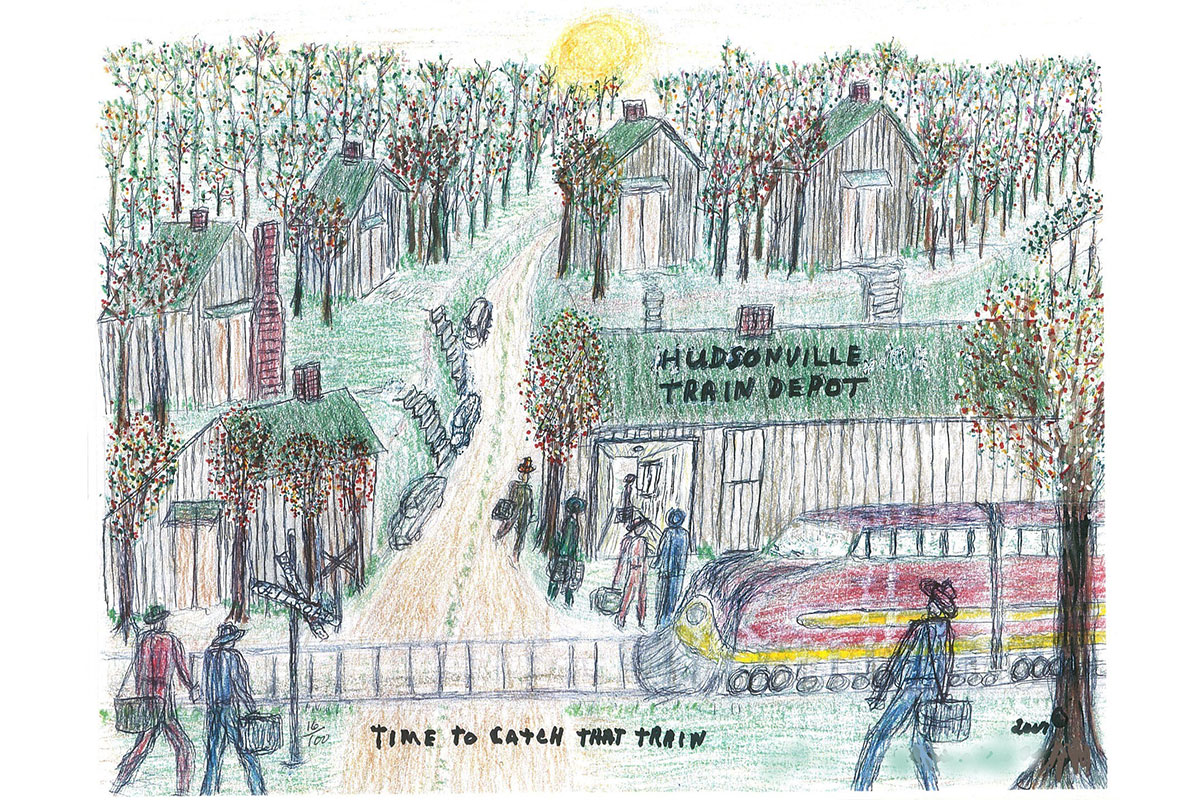
The exhibition, now on view through Dec. 10, 2022, at the Columbus State University’s Bo Bartlett Center in Columbus, Ga., travels next to Francis Marion University’s Steven F. Gately Gallery in Florence, S.C. The tour continues at the 701 Center for Contemporary Art in Columbia, S.C., from March 9 to May 7, 2023, and at the Hilliard Art Museum at the University of Louisiana in Lafayette from Aug. 19 through Dec. 16, 2023.
Suggs’ pictures celebrate self-determination and community. “My main thing was to show people a different side of being poor,” Suggs says of her inspiration and concentration on times past. “See, it’s one thing about being poor, but if you didn’t know you were poor that was a whole different ball game.”
In the era she depicts, people took pride in what they had, she explains. Suggs notes the absence of cars in her “Tree Shelter,” which represents how many people had to walk for miles to get to town before automobiles became commonplace, a time when a tree’s shelter served as a place to rest for a moment and to ready oneself for town.
“When you got under the Shelter Tree, you took your good shoes out, and you put them on,” Suggs says, explaining that pedestrians would leave their walking shoes at the base of the tree for the return trip home. “So, when you got to town, you looked just like everybody else. … You had pride. You put on your best clothes to go to town, to catch the school bus, whatever.”

“That’s what I try to show in my artwork, that you deal with the deck that you have, or you shuffle with the deck that you have,” she says. “You don’t go out, wanting something that you can’t afford, and you learn how to appreciate the place where you are. I try to pass that on to other generations.”
‘Too Young to Stop Doing’
Pride and hard work run deep in Suggs’ background. She grew up four miles southwest of the rural community of Slayden in north Mississipi’s Marshall County, the 11th of 17 children on a 160-acre family farm. Those lessons in self-sufficiency sustained her, providing the necessary fortitude she would need later in life.
Suggs began her profession as a teacher in Clarksdale, Miss., for two years, then moved to Memphis, where she taught for the next 28 years. The career she built—teaching AP biology, helping set up a computer-science program in the city’s schools, coordinating workshops with the Southeastern Consortium for Minorities in Engineering—came to a halt in 1985 when a freak accident caused her injury.
She was in her 40s at the time, pursuing professional development. The older science building where the teachers met lacked air-conditioning, with windows that opened to the inside. Sugg’s seat happened to be right below one of those metal-framed, in-hanging windows. When she stood as her name was called, the corner caught her head. The effect of the blunt force trauma set up a cascade of health issues, including strokes, seizures and necessary surgeries.
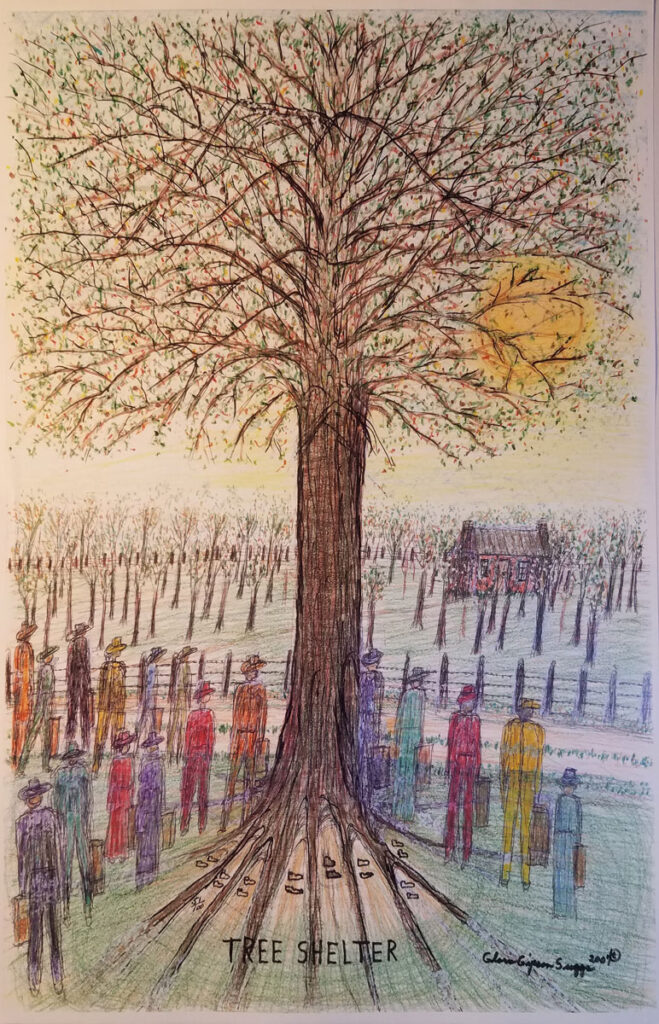
“I couldn’t work for about four years or so. I really couldn’t do nothing,” Suggs says of the long recovery. “Well, I’ve got to do something,” she told herself at the time. “I was too young to stop doing.” That conclusion led her to ask her family for crayons.
The rural setting of her childhood had a big influence on her pictures, with the self-sufficient lifestyle coming through in scenes of home and farm life. “That’s what you had to do in order to live,” she says. “You had to make your own clothes, raise your own food.”
‘Not Skip(ing) Over the Rough Stuff’
Art became a way to reconnect with her own personal past and the ways of her ancestors, as well as an avenue to explore a creative side that had never been far from the surface, spilling out in poems, songs and stories even before she embarked on her visual-art journey.
Progress in recovery at times seemed like the “piece-a-way” ritual she writes about in her 2013 self-published book of fiction, poems and art, “Piece-A-Way Crossroads.” The phrase refers to a rural custom, in which hosts followed their visitors back toward home. The group edged along partway, then back a shorter distance, then forward, back and forth, until the visitors’ home was in sight. “It’s like you’re going backward, but you still get home,” Suggs describes it.
Muscular problems from her injury make her artwork a time-intensive endeavor. Family members—husband Franklin and children Linda and Michael—were a big help, she says, gathering materials and encouraging her artistic expression. They wanted to try to teach her acrylics.
“No, I’m not in any shape to learn anything,” she told them.
“I thought, if I’m doing crayon, I’m going to do things from the primitive impression style, because I’m not a trained artist,” she recalls. “But I’m going to capitalize on things I knew or felt as a child, but still not skip over the rough stuff. But I’m not going to do anything to scare a child.”
“So, it may seem like, if you’re just looking at my painting and not knowing where I’m coming from, you may think it’s all glossy and nice,” Suggs adds. “But a child, even at that age, could recognize hard times, bad times, cruelty, love, joy.”
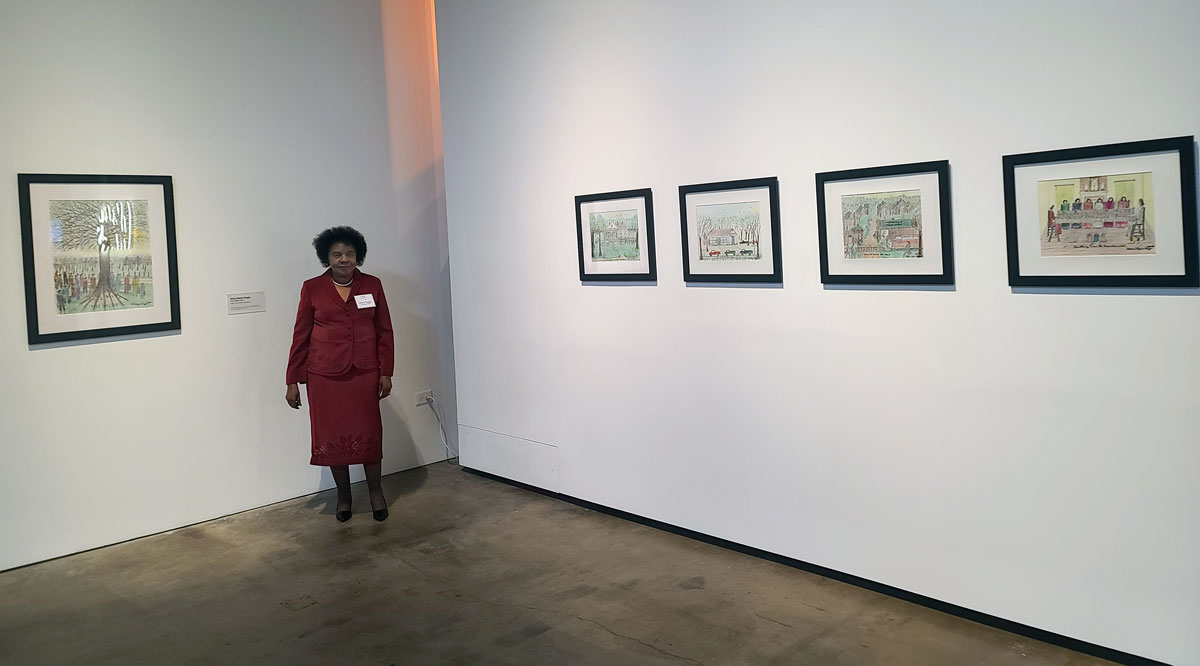
Mahogany is the color she uses on faces. “We grew up in a mixed community, where everybody had to work hard in order to survive. You had to get along in order to get through life where I grew up, and I use mahogany because it shows joy on a child’s face,” Suggs says. “It doesn’t show the mean, hateful stuff, because the child knew what was going on but they cherished the good moments.”
Faith plays a big part, too, for Suggs, a member of St. Joseph Catholic Church in Holly Springs. She was born in a Baptist household and converted to Catholicism as a schoolgirl. The Baptist gospel sound stuck with her, though, and she aims to capture that style in her songs, working with studios to put them to music. Her first single, “Steep Is the Stairway to Heaven” and “I Feel the Presence of God” preceded her injury, as did her first book of poetry and narrative, “Wind-blown Memories.”
Those forays had put her in the public eye a bit already, before her injury. The addition of artwork led to invitations for her to put on shows that combined art, song and stories.
“It was like God closed one big door and opened up three big doors together,” Suggs says. “I couldn’t believe it.”
Her creative output since then includes a CD of contemporary gospel songs, “Such a Beautiful Day,” in 1990 and books “Reflections in Black and White with Shades of Red, Yellow and Brown” in 1998 and “Piece-A-Way Crossroads” in 2013. She aspires to finish a novel in the future.
‘The Joy Came Down’
At first, Suggs gave her artwork to people as gifts. “My family said, ‘You’re doing pretty good at it; why don’t you sell them instead of giving them away?’”
They helped her make contacts with places to display and sell her works. At her first public showing, an art festival in Germantown, she packed loose sheets of her art in milk crates, and rolled up sales with a rubber band. Buyers bought everything she carried with her, and Suggs, still recovering, wondered whether customers had made the purchases out of pity. Nonetheless, she kept at it, refining her display and signing and packaging her art.
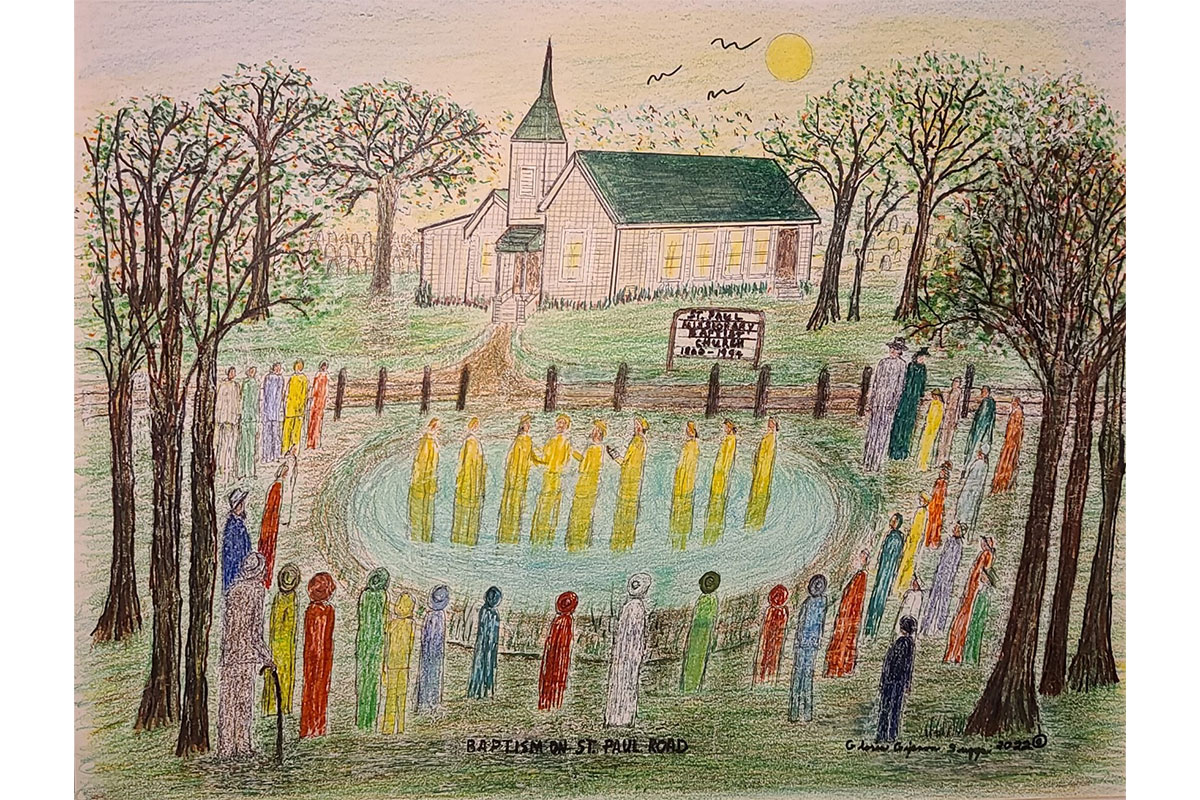
Sales continued at one place after another, at arts and crafts festivals in Chicago, Nashville, Atlanta, Carthage, Corinth, Oxford, Memphis and other cities.
“That was when the joy came down,” she says. “Something happened to me to show me, you can be in one place, but you’ve got to pull yourself up by your bootstrap, to get back into another place. You can’t just lay there, with ‘woe is me’ stuff.” I’m going to tell you the truth; it’s just been a treat.”
With physical therapy, her recovery enabled a return to work as her health permitted, at Southeast College of Technology and at Charter Lakeside Behavioral Health System. She worked with the alternative program for Holly Springs and Marshall County school systems until retirement. She and her husband bought the family farm where he had grown up in Chulahoma (18 miles west of Holly Springs) in 1992, and they still call that land home today.
Recognition as a South Arts’ 2022 Mississippi Fellow joins other accolades she has received for her art, for her work in education and for her community leadership. “I was so excited. That’s a great award for me,” she says. With her $5,000 fellowship, she made donations to the Ida B. Wells Museum and to Rust College, which both showcase area artists, and she used the remainder for a display backdrop at her home, for when she exhibits artwork there.
“I look at awards, not for the amount of money,” Suggs says, “but the gratitude people have, in the work that I’m doing.”

